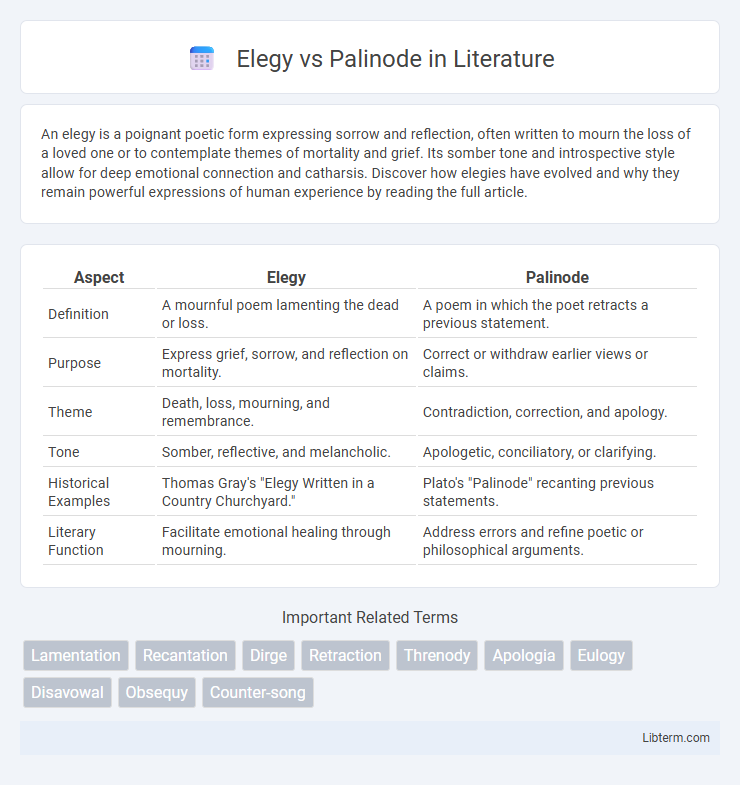An elegy is a poignant poetic form expressing sorrow and reflection, often written to mourn the loss of a loved one or to contemplate themes of mortality and grief. Its somber tone and introspective style allow for deep emotional connection and catharsis. Discover how elegies have evolved and why they remain powerful expressions of human experience by reading the full article.
Table of Comparison
| Aspect | Elegy | Palinode |
|---|---|---|
| Definition | A mournful poem lamenting the dead or loss. | A poem in which the poet retracts a previous statement. |
| Purpose | Express grief, sorrow, and reflection on mortality. | Correct or withdraw earlier views or claims. |
| Theme | Death, loss, mourning, and remembrance. | Contradiction, correction, and apology. |
| Tone | Somber, reflective, and melancholic. | Apologetic, conciliatory, or clarifying. |
| Historical Examples | Thomas Gray's "Elegy Written in a Country Churchyard." | Plato's "Palinode" recanting previous statements. |
| Literary Function | Facilitate emotional healing through mourning. | Address errors and refine poetic or philosophical arguments. |
Introduction to Elegy and Palinode
An elegy is a mournful poem or song expressing sorrow for someone who has died, often reflecting on themes of loss and mourning. A palinode is a poetic form in which the author retracts a statement made in an earlier poem, effectively taking back or correcting previous verses. Both forms serve distinct purposes in literature: elegies commemorate and lament, while palinodes offer poetic recantation and revision.
Defining Elegy: Meaning and Purpose
An elegy is a reflective poem expressing sorrow or mourning, often written to honor someone who has died, serving as a lament for loss and a meditation on mortality. Elegies traditionally follow a solemn tone and explore themes of grief, remembrance, and consolation, aiming to provide emotional catharsis and tribute. This genre of poetry contrasts with a palinode, which involves retracting a previous statement, highlighting the elegy's role in permanent, heartfelt commemoration.
Understanding Palinode: Origins and Significance
A palinode is a poetic form in which the author retracts or revokes a statement made in a previous poem, often as an expression of regret or correction. Originating in ancient Greek literature, it derives from the Greek words "palin" (again) and "oide" (song), emphasizing its function as a "second song" to amend the first. The significance of the palinode lies in its reflective nature, allowing poets to engage in self-critique and thematic revision, contrasting with the elegy's focus on mourning and lamentation.
Historical Development of Elegy
The historical development of elegy traces its origins to ancient Greek and Roman poetry, where it was primarily composed in elegiac couplets to express mourning and lamentation. Over time, elegies evolved from formal funerary poems to more varied meditations on loss and reflection, as seen in the works of poets like Ovid and later in the English Renaissance. Unlike the elegy, a palinode emerged as a poetic form designed to retract or recant previously stated sentiments, often used by poets to amend their earlier elegiac expressions.
Evolution and Characteristics of Palinode
The palinode evolved as a specialized poetic form that retracts or recants a previously stated sentiment, distinguishing itself from the elegy, which traditionally mourns loss or reflects on grief. Characterized by its introspective tone and corrective intention, the palinode often revises earlier verses to convey repentance or clarification, showcasing a dynamic interaction between poet and subject matter. This form highlights the evolution of poetic expression, emphasizing revision and intellectual engagement over the elegy's consistent focus on lamentation and memorialization.
Key Differences Between Elegy and Palinode
An elegy is a reflective poem mourning the loss of someone or something, characterized by its somber tone and themes of lamentation and consolation. In contrast, a palinode is a poetic form in which the author retracts or recants a previous statement or belief, often correcting or clarifying an earlier work. The key difference lies in purpose: elegies express grief and remembrance, while palinodes serve to amend or withdraw prior assertions.
Notable Examples of Elegies
Notable examples of elegies include John Milton's "Lycidas," which laments the death of a fellow poet, and W. H. Auden's "In Memory of W. B. Yeats," honoring the late poet. Elegies traditionally express sorrow and mourning, contrasting with palinodes, which are poems that retract or recant a previous statement. The distinction emphasizes the elegy's role in memorializing loss rather than reversing prior declarations.
Famous Palinode Compositions
Famous palinode compositions include Stesichorus's correction of his earlier poem about Helen, which reversed his previous slanderous depiction, and Alexander Pope's "An Epistle to Dr. Arbuthnot," where he retracts earlier criticisms. Unlike elegies that mourn loss or lament, palinodes are poetic retractions or recantations of previous statements. These works hold significant literary value for their self-corrective nature and rhetorical impact.
Cultural and Literary Impact
Elegies have profoundly influenced Western literature by expressing collective mourning and reflection on loss, shaping poetic traditions from ancient Greece to modern times. Palinodes, though less common, serve a unique cultural role by offering poetic retractions or corrections, highlighting evolving perspectives and intellectual humility in literary discourse. Both forms enrich cultural narratives by exploring themes of regret, memory, and reconciliation, thus deepening the emotional and philosophical dimensions of poetry.
Choosing Between Elegy and Palinode in Modern Writing
Elegy and palinode serve distinct purposes in modern writing, with elegies expressing sorrow over loss and palinodes retracting previous statements or opinions. Writers choose elegies to convey deep mourning and reflection, often commemorating a deceased person or a significant loss. In contrast, palinodes are ideal when authors seek to correct or reconsider earlier views, demonstrating intellectual growth or repentance.
Elegy Infographic

 libterm.com
libterm.com